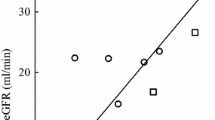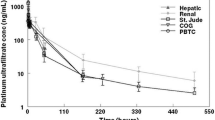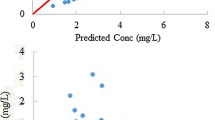Summary
Cyclophosphamide pharmacokinetics were studied in seven patients with moderate to severe renal insufficiency (creatinine clearances 0–51 ml · min−1), and compared with a matched control group of patients with normal renal function. The mean half-life of cyclophosphamide following intravenous administration in the normal group was 8.21±2.33 (SD) h whilst that in renal failure was 10.15±1.80 h: these were significantly different. The total body clearance in the normal control group was 58.6±10.9 ml·kg−1h−1 which was significantly larger than in renal failure where it was 48.8±10.9 ml·kg−1h−1. Vd β, Vd ss and Vc were not significantly different between the two groups. A linear relationship exists between β, the first order disposition rate constant and endogenous creatinine clearance since this drug shows a relatively small degree of compartmentalisation. The plasma half-life of phosphoramide mustard, a cytotoxic metabolite of cyclophosphamide, shows a parallel and significant increase in renal failure with the parent compound. The t1/2 in normal patients was 8.33±2.0 h, whilst in the renal failure group it was 13.37±4.23 h. Total alkylating activity as measured by the nitrobenzylpyridine reaction showed a significant increase in renal failure. This data suggests that in pharmacokinetic terms it may not be necessary to alter the dose of cyclophosphamide until there is severe renal impairment. Further studies correlating the efficacy and toxicity of the drug with its pharmacokinetics in renal failure are necessary.
Similar content being viewed by others
References
Bagley CM, Bostick F, De Vita T (1973) Clinical pharmacology of cyclophosphamide. Cancer Res 33: 226–233
Bramwell V, Calvert RT, Edwards G, Scarffe H, Crowther D (1979) The disposition of cyclophosphamide in a group of myeloma patients. Cancer Chemother Pharmacol 3: 253–259
Brock N (1976) Comparative pharmacologic study in vitro and in vivo with cyclophosphamide (NCS-26271), cyclophosphamide metabolites and plain nitrogen mustard compounds. Cancer Treat Rep 60: 301–307
Cockcroft DW, Gault MH (1976) Prediction of creatinine clearance from serum creatinine. Nephron 16: 31–41
Colvin M (1978) A review of the pharmacology and clinical use of cyclophosphamide. In: Pinedo (ed) Clinical pharmacology of antineoplastic drugs. Elsevier/North Holland, Biomedical Press, Amsterdam, pp 245–261
Dettli L (1977) Elimination kinetics and dosage adjustment of drugs in patients with kidney disease. Progress in Pharmacology, Vol 1, No. 4. Gustav Fischer, Stuttgart New York
Dvorchik BH, Vesell ES (1978) Significance of error associated with use of the one-compartment formula to calculate clearance of thirty-eight drugs. Clin Pharmacol Ther 23: 617–623
Fenselau C, Kan M-N N, Subba Rao, Myles A, Friedman OM, Colvin M (1977) Identification of aldophosphamide as a metabolite of cyclophosphamide in vitro and in vivo in humans. Cancer Res 37: 2538–2543
Friedman OM, Boger E (1961) Colorimetric estimation of nitrogen mustards in aqueous media. Hydrolytic behaviour of Bis (beta-chloroethyl) amine, Nor HN2. Anal Chem 33: 906–910
Gibaldi M, Perrier D (1972) Drug distribution and renal failure. J Clin Pharmacol 12: 201–204
Humphrey RL, Kvols LK (1974) The influence of renal insufficiency on cyclophosphamide induced hematopoietic depression and recovery. Proc Am Assoc Cancer Res 15: 84
Jardine I, Fenselau C, Appler M, Kan MN, Brundrett RB, Colvin M (1978) Quantitation by gas chromatography-chemical ionisation mass spectrometry of cyclophosphamide, phosphoramide mustard and nor-nitrogen mustard in plasma and urine of patients receiving cyclophosphamide therapy. Cancer Res 38: 408–415
Jarman M, Milsted RAV, Smyth JF, Kinas RW, Pankiewicz K, Stec WT (1979) Comparative metabolism of 2-(bis (2-chloroethyl) amino) tetrahydro-2H-1, 3,2-oxaza-phosphorine-2-oxide (cyclophosphamide) and encitiomers in humans. Cancer Res 39: 2762–2767
Juma FD, Rogers HJ, Trounce JR, Bradbrook ID (1978) Pharmacokinetics of intravenous cyclophosphamide in man, estimated by gas-liquid chromatography. Cancer Chemother Pharmacol 1: 229–231
Juma FD, Rogers HJ, Trounce JR (1979) Pharmacokinetics of cyclophosphamide and alkylating activity in man after intravenous and oral administration. Br J Clin Pharmacol 8: 209–217
Juma FD, Rogers HJ, Trounce JR (1980) The pharmacokinetics of cyclophosphamide, phosphoramide mustard and nor-nitrogen mustard studied by gas chromatography in patients receiving cyclophosphamide therapy. Br J Clin Pharmacol 10: 327–335
Levine S, Savinsky R (1975) Role of the kidney in development of cystitis and other toxic effects of cyclophosphamide. Invest Urol 13: 196–199
Mouridsen HT, Jacobsen E (1965) Pharmacokinetics of cyclophosphamide in renal failure. Acta Pharmacol Toxicol 36: 409–414
Nelder JA, Mead R (1965) A simplex method for function minimisation. Computer J 7: 308–313
Sensenbrenner LL, Marini JJ, Colvin M (1979) Comparative effects of cyclophosphamide, isophosphamide, 4-methyl 1 cyclophosphamide and phosphoramide mustard on murine hematopoietic and immunocompetent cells. J Natl Cancer Inst 62: 975–981
Sladek NE (1973) Evidence for an aldehyde possessing alkylating activity as the primary metabolite of cyclophosphamide. Cancer Res 33: 651–658
Takamizawa A, Matsumoto S, Iwata T (1975) Studies on cyclophosphamide metabolites and their related compounds II. Preparation of an active species of cyclophosphamide and related compounds. J Med Chem 18: 376–383
Author information
Authors and Affiliations
Rights and permissions
About this article
Cite this article
Juma, F.D., Rogers, H.J. & Trounce, J.R. Effect of renal insufficiency on the pharmacokinetics of cyclophosphamide and some of its metabolites. Eur J Clin Pharmacol 19, 443–451 (1981). https://doi.org/10.1007/BF00548589
Received:
Accepted:
Issue Date:
DOI: https://doi.org/10.1007/BF00548589




